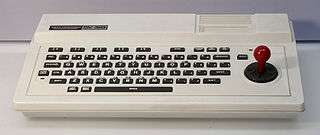SV-318
 | |
| Type | Home computer |
|---|---|
| Release date | 1983 (Winter CES, Las Vegas) |
| Media | ROM Cartridge, cassette tape, 5¼-inch floppy disks |
| Operating system | Microsoft Extended BASIC |
| CPU | Zilog Z80A @ 3.6 MHz |
| Memory | 16 KB (+16 KB video memory) |
| Display | 256×192 resolution, 16 colours |
| Input | Keyboard |
| Successor | SV-328 |
The SV-318 is the basic model of the Spectravideo range. It was fitted with a chiclet style keyboard, difficult to use, alongside which sat a combination cursor pad/joystick. This is a disc-shaped affair with a hole in the centre; put a red plastic 'stick' in the hole and it is a built-in joystick, remove the stick and it is a directional arrow pad for word processing etc. This machine also had only 16 kb of user RAM (plus an additional 16 kb of video RAM), which limited its usefulness, though this could be expanded via an external peripheral box.
This machine is basically identical to its big brother the SV-328, the only differences being in the keyboard and amount of memory. The ROM, expandability, mainboard and case of the two machines were identical.
Reference to the operating system Microsoft Extended BASIC is not to be confused with MSX BASIC, although some marketing at the time claimed that Microsoft Extended is what MSX stood for. The SV-318 is not fully compliant with the MSX standard.
In 1983 Spectravideo announced the SV-603 ColecoVision Video Game Adapter for the SV-318. The company stated that the $70 product allowed users to "enjoy the entire library of exciting ColecoVision video-game cartridges".[1]
Reception
Popular Mechanics in February 1984 stated that the Spectravideo SV-318 "is worth searching out ... a very nice little machine". The magazine liked the integrated joystick and "stunning" graphics, but advised consumers to consider the small software library before purchasing.[2]
System specs
- Processor: Zilog Z80A running at 3.58 MHz[3]
- ROM: 32 KB
- RAM: 16 KB
- Video Display Processor: Texas Instruments TMS9918
- VRAM: 16 KB
- Text modes: 40×24 and 32×24
- Resolution: 256×192 (16 colours)
- Sprites: 32, 1 colour, max 4 per horizontal line
- Sound chip: General Instrument AY-3-8910 (PSG)
- Programmable Peripheral Interface : Intel 8255
References
- ↑ "Heavy Hardware". Softline. March 1983. p. 46. Retrieved 28 July 2014.
- ↑ Shapiro, Neil (February 1984). "Big Bytes for Little Bucks". Popular Mechanics. pp. 98–99,139–142.
- ↑ "The history of Spectravideo". 2008. Retrieved 2009-07-17.